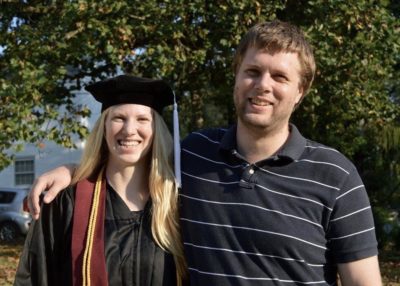
Patrick Kenny before he was fatally shot by police.
(7-30-20) Dr. Mark Muentz wrote about the importance of Crisis Intervention Team training in a Monday blog post, but what happens when officers who have received CIT training are involved in a violent incident with someone who has a serious mental illness. In today’s blog – one in a series that I am posting about shifting responsibility for the seriously mentally ill from the police to social service agencies and the medical community – we hear from Kimberly Kenny, whose brother, Patrick aka Stacy, was fatally shot by police in Springfield, Oregon.
Crisis Intervention Training Didn’t Prevent Four Police Officers From Assaulting and Killing My Brother
Guest blog by Kimberly Kenny
The entire incident took less than five minutes.
It happened a little before 9 pm on a Sunday, near a hardware store Patrick liked to go to sometimes.
Officer Kraig Akins saw Patrick driving and ran his license plate, and then didn’t see Patrick’s car again for another two minutes, when they happened to cross paths again. Patrick was driving west on Olympic Street, Akins was on a side street and as Patrick passed, Akins pulled out behind Patrick. Akins’ lights and siren were off. Patrick immediately signaled and pulled over, probably because he was scared and hoped the policeman would drive by.
Patrick had paranoid schizophrenia and one of his biggest fears was the police. He was kind and generous and smart, and with his schizophrenia sometimes he acted weirdly but never violently.
“First Stop” By Police
After Patrick stopped, Akins pulled in behind him and turned on his lights but not his siren. Akins got out of his car and stood there for 30 seconds. We call this “the first stop.” After 30 seconds, Patrick rolled down his window and tossed a small noisemaker toward Akins. The thing with the noisemaker is Patrick thought it would somehow protect him, kind of like a “rape alarm.” He’d given mom and me our own and urged us to use it for protection, that it would keep the bad guys away. I still have the noisemaker he gave me as a present the last time I visited.
Akins took a step back but didn’t do anything. Patrick waited another 15 seconds and then made a U-turn and drove eastward at about 25mph.
Akins called for backup, got back into his car, followed Patrick, and turned his lights and siren on.
Second Stop
They traveled about two blocks at 25 mph and then Patrick pulled over. This was “the second stop.”
Akins got out of his car with his gun at “high ready” with its barrel pointed down towards the ground. He approached Patrick’s car but didn’t go all the way up to it. Maybe at this point, we don’t know for sure, Patrick blew an airhorn out of his window. Like with the noisemaker, it was a noisemaking thing that he somehow thought (schizophrenia) would keep him safe. So he might have blown an airhorn out his window.
He also called 911. The rest of the encounter was recorded on that call and is public record. A local newspaper, The Register-Guard, posted a video compilation of the 911 call, radio chatter between officers, and building security footage.
The first thing you hear on the 911 call is Patrick yelling “You’re trying to harass me! Why?!” The female 911 operator is trying to figure out what’s going on. Then you hear a repeated back-and-forth.
Patrick yells “Why? What did I do wrong?”
Officer Akins yells “Get out of the car! Put your hands out of the car!”
“What did I do wrong?!”
“Get out of the car!”
“What did I do wrong?”
Over and over, as the 911 operator is telling her colleagues what’s happening and wondering what she should do.
My brother drives back on the road and continues eastward at about 25mph. Akins gets back in his car and follows him.
Third and Last Stop
They drive about two blocks before Patrick pulls over again.
Akins pulls up behind him. Sergeant RA Lewis (remember Akins had called for backup) arrives at about the same time and pulls in front of Patrick’s car, boxing Patrick in.
Now for the violence.
Akins gets out of his car with his gun drawn, goes to the driver’s side of Patrick’s car, puts his gun away and immediately breaks the window (with a window-breaking device he keeps with him).
By Akins’ own sworn deposition, he never spoke to Patrick or asked Patrick to roll down the window or get out of the car or considered any other action, he immediately broke the window.
Officer Akins then tried to pull Patrick out of the window by his hair.
When that didn’t work, Akins held Patrick’s hair with his right hand and punched Patrick 7-13 times in the face with his left hand. He hit Patrick so hard that he fractured his hand (a “brawler’s fracture”.)
Meanwhile, Officer RA Lewis has gone to the passenger side with his gun drawn. He points it at Patrick, but puts the gun down when he sees Akins on the other side of the car. Lewis testified that he could see Patrick was on the phone, unarmed, and that no one else was in the car.
A third officer, Robert Rosales, arrives. He runs to Patrick’s window and also tries to pull Patrick out of the window by his hair. When that doesn’t work, he also punches Patrick in the face, 3-5 times.
A fourth officer, Robert Conrad, joins them. He also goes to Patrick’s driver’s side window. He grabs Patrick’s sweatshirt in an attempt to pull Patrick from the car. He pulls Patrick’s sweatshirt off his body.
At this point, Officer Conrad begins using his Taser on my brother.
Officer Akins draws his Taser and begins tasing Patrick too.
In the meantime, Sergeant Lewis gone to driver’s window and then back to the passenger window. Before Conrad begins tasing, Lewis breaks the window with his knife. Reaching through the window, he opens the door, and gets into the car on the passenger side. He leans in with only his right ankle hanging out.
He punches Patrick 3-5 times in the face.
By now, Patrick was being Tased by Akins and Conrad on his left and punched by Lewis on his right. He was seat belted in his car the entire time.
Lewis hits Patrick in the back of the head with the back end of his knife – maybe it was now or maybe it was seconds later – and this fractures Patrick’s skull.
Their actions – Akins pulling and punching, Rosales pulling and punching, Conrad pulling and tasing, Akins tasing, Lewis punching, Lewis hitting my brother with his knife – lasts for about a minute and a half.
Patrick then drives away. He bumps Lewis’ squad vehicle in front of him and manages to slide around it onto the street.
Honestly, maybe I would have done the same thing at this point, even if only as an instinctual reaction to save my own life while being beat up.
Officer Lewis is still in the car on the passenger seat with his ankle hanging out.
On the 911 call you can hear Lewis yelling: “Stop the fucking car! Stop the car or you’ll kill us both!”
This comment was emphasized later in the press conference on April 16, 2019 as if to say “See, Lewis warned him.” But in the press conference officials omitted the “fucking” that Lewis had said. In a briefing for the family before the press conference, officials also stated that Patrick was swearing at the officers. But Patrick didn’t swear (yes, he had weird noisemakers and blow horns, but he didn’t swear) and this is nowhere on the 911 call. After yelling, Lewis draws his gun.
Lewis shot Patrick three times in the torso, somehow missed a shot at point blank range, and shot Patrick twice in the head.
Patrick is dead.
Lewis testified later that it was the only way to get control of the car and save his life.
Lewis then careened the car to the right and crashed through a fence before hitting a parked car. This is when he received his injuries for which he was hospitalized.
On the radio dispatch between the officers, the last thing you hear is Officer Conrad saying: “Bad guy down.” The newspaper articles would call Patrick a “suspect.”
Suspected of what?
This last encounter lasted less than five minutes. That was March 31, 2019.
This tragedy was unnecessary. This tragedy was preventable.
The 911 dispatcher told all four officers’ via radio dispatch that she was talking to Patrick on the phone while they were assaulting him.
Eight months before my brother was killed, my parents had gone personally into the Springfield Police Department to inform them that Patrick had schizophrenia and that Patrick might act weirdly but wasn’t violent. The officers didn’t know whom they had killed until after Patrick was dead.
Officer RA Lewis was the CIT – Crisis Intervention Team – trainer, and is meant to be an expert in de-escalation.
The other three officers have all completed their 40 hours of CIT training.
Yet none of the four individuals who brought about Patrick’s death made any attempt at de-escalation, even according to their own sworn testimonies. Neither Akins nor the officers paused long enough to say “This guy is acting strangely; maybe we should find out why?” or “Maybe we should try talking to him instead of breaking the windows.”
What was the hurry to extract Patrick from the car immediately, especially when they had him boxed in with their cars and Lewis clearly saw Patrick was unarmed and not a threat? Why not slow down and think? Why go straight to violence?
I watched all of the officers’ sworn depositions. I read all the evidence I was allowed to read. I have tried to empathize with them. I’ve tried to imagine what Akins was experiencing.
What I come up with makes me physically sick. Toxic violence and fear.
If you are so afraid of an individual like Patrick, who does a few “weird” things like toss a noisemaker out a window, shout “What did I do wrong?” and drive away at the speed limit, so afraid that you have to physically assault that person, then you should not be a police officer. Police officers need to be brave and they need to care – genuinely care – for their communities.
Akins, Lewis, Rosales, and Conrad showed anything but bravery. It was violence and a toxic need for the feeling of power that comes with making another human submit.
People have asked “what happened to the officers.”
Nothing essentially.
Officer Kraig Akins (the one who initiated the contact and fractured his hand punching Patrick in the face), Sergeant RA Lewis (the one who entered Patrick’s car, hit Patrick with the blunt end of his knife so hard that it fractured Patrick’s skull, and the one who shot him five times), Officer Robert Rosales (third officer on the scene, who punched Patrick 3-5 times), and Officer Robert Conrad (the one who pulled Patrick’s sweatshirt off and initiated the use of a stun gun) have faced zero disciplinary action.
In fact, Lewis received a medal for his actions on March 31, 2019 from the Oregon Peace Officers Association. He also hired a personal injury lawyer who threatened to sue my parents for the damages he suffered after shooting Patrick and crashing Patrick’s car, sending a demand letter directly to my parents’ home address instead of to their lawyer.
What kind of person does that?
I will never forget their names – Akins, Lewis, Rosales, and Conrad – who probably have no idea how their actions have impacted my and my family’s lives. These officers are still on the street. They won’t be fired. They won’t face any criminal charges.
One reason the officers haven’t faced criminal charges is because of Lane County District Attorney Patty Perlow. Another name I’ll never forget. Patty Perlow ruled my brother’s death was a non-criminal homicide because Officer Lewis had a “reasonable fear for his life” at the instant that he pulled the trigger.
Only at that instant. But what about all the events that put Lewis in that situation where he was in the car with Patrick? What about assaulting Patrick and entering Patrick’s private property before shooting him?
District Attorney Patty Perlow has not investigated any of these officers’ actions leading up to the actual shooting and to date, she has declined to do so. Are all of the officers’ actions leading up to the actual shooting also non-criminal use of force?
In the private meeting that she had with our family the day before the press conference, and at her public press conference, she didn’t mention any of the violence against my brother preceding the shooting. She emphasized instead that Patrick was a big guy and Lewis a small guy (she didn’t mention Officer Akins’ size – as big or bigger than Patrick). She emphasized that Patrick had toilet paper and food in his car (schizophrenia). She emphasized how Lewis considered all his options before shooting Patrick in the head, as if Lewis was thinking carefully and rationally in that moment, but you can hear on the 911 call how rapidly Lewis shoots – there was no real pause between three torso shots and two head shots.

District Attorney Perlow declined to prosecute officers.
Is killing the driver really the best way for officers to get control of the car?
District Attorney Patty Perlow got the facts wrong in the press briefing. She said Officer Conrad arrived before Patrick’s windows were broken, and she never mentions Officer Rosales. She would have seen these facts by simply watching the nearby building security footage.
At the very best, Patty Perlow was woefully uninformed and never really read the report about what happened. At worst she is purposely misrepresenting, even lying, about the facts. Her actions in particular have caused my family additional trauma that was completely unnecessary. One lesson we’ve learned from this is that District Attorneys need to be truly impartial.
I wish I could go back to that first private meeting we had with her with the information I know now, and look her in the eye.
By Oregon Law, even if a use of deadly force is unconstitutional, it is not necessarily criminal. In Oregon it is not a crime for an officer to use deadly force if the officer has a realistic fear for his life at the instant he uses deadly force. That fact alone, with none of the surrounding information including what leads up to that instant decision, can be enough to shield a police officer who kills someone in Oregon from criminal prosecution.
That law needs to change.
I try not to feed my anger.
I don’t need to lose precious time in life thinking about the people who don’t deserve that consideration. I know that (unfortunately) there is plenty of police reform work, mental health work, toxic masculinity / culture of violence work to be done in my lifetime and that that’s where I can redirect my righteous anger and passion, like a Dragon Ball Z character redirecting a fireball. The best way I’ve decided I can contribute is get involved in these causes and to tell our story, even if at first it’s with a halting voice and awkward phrasing.
I hope that by reading this you’ll have gained an insight into police shootings and police violence. I hope that being one or two degrees separated from me will make these experiences more relevant to you and if nothing else you’ll simply be more aware. Thank you for listening.

Patrick with his sister, Kim, author of this blog post.
(Editor’s note: A wrongful death lawsuit by the family against the four officers, the Springfield Police Department (SPD), and the City of Springfield, Oregon, was settled out of court on July 9, 2020.
In addition to financial damages, the family successfully demanded a series of reforms:
- The SPD will now be reviewed bi-annually by an external auditor and the results publicly presented and posted on their website.
- SPD must curate use of force statistics and share them publicly.
- They must completely revamp their administrative review board of Use of Force incidents and appoint board members who have had external training on how to properly conduct a Use of Force review.
- The policy language around use of force has been changed to hold them to a higher standard.
- SPD must create an annual award for the officer who has best de-escalated a situation without resorting to force.
The settlement amount is $4.55 million, the highest settlement in Oregon history. The Kennys plan to use their portion of the settlement to support important mental health research and advocacy, both within the Springfield community and nationally.
“Nothing will bring Patrick back. And there is no amount of money to replace loss. The benefit of this amount is that it’s high enough to make a statement and for people to sit up and take notice. Killing citizens cannot be cheap,” Kimberly Kenny stated. The Kenny’s Complaint (lawsuit), Press Release, and video about their brother and son can be found on a family website created for the purpose of sharing more information about the case: https://kenny-family.com/
A note on naming: Patrick liked to be called Patrick and “he” by family and friends, and Stacy and “she” by the outside world. His schizophrenia led him to believe that if the outside world thought of him as female, then society would generally treat him better and he would be safer, but with family and friends he identified as a cis man. Kimberly Kenny referred to her brother as Patrick throughout this blog.

The Kenny Family: Kimberly, Barbara, Patrick/Stacy and father, Chris.



